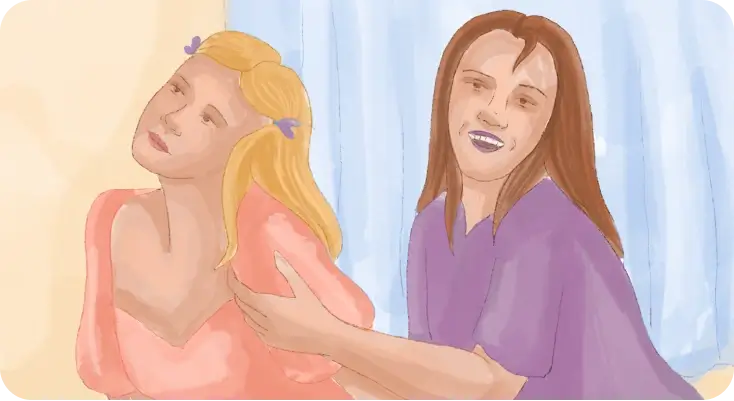How do people tend to imagine a person with attention-deficit/hyperactivity disorder? It may be someone who struggles to concentrate, is always in a hurry, and finds it difficult to sit still.
While these are well-known and common symptoms of ADHD, there are also those most of us might be unaware of.
Dr. Daniel Amen, psychiatrist and brain imaging specialist, suggests there are 7 different types of ADD, each hosting different challenges. Ring of Fire ADD is one of them.
If you face daily life challenges and suspect yourself living with ADD symptoms, it may be helpful to consider Dr. Amen’s work, discussed below. Maybe you don’t experience classic attention-deficit/hyperactivity disorder but another type of this neurodevelopmental condition.
Below, we’ll answer the question, “What does Ring of Fire mean?” and delve deep into its symptoms, potential causes, and treatments. You’ll also learn more about the other six types of ADHD, so keep reading.
Is it ADD or ADHD?
You may notice that we’re using the term ‘ADD’ instead of ‘ADHD.’
It’s important to note that in the medical, psychiatric, and psychological communities, Attention-Deficit Disorder (ADD) was renamed in 1987 as Hyperactive Attention Deficit Disorder (ADHD).
It’s currently divided into three types:
- Predominantly Hyperactive
- Predominantly Attention-Deficit
- Predominantly Hyperactive and Attention-Deficit
While the term ‘ADD’ has been considered outdated since the late 80s, Dr. Amen intentionally utilizes the term ‘ADD’ instead of ‘ADHD’ due to the fact that hyperactivity is a symptom that is not necessarily present across all the different seven types that he suggests.
What Is the Ring of Fire ADD?
Let’s start with an important disclaimer: The American Psychiatric Association (APA) does not recognize these hypothetical 7 types of ADD, including the Ring of Fire. Nor are these diagnosable conditions found in the Diagnostic and Statistical Manual of Mental Disorders (DSM-5).
Nevertheless, Dr. Daniel Amen, in his book “Healing ADD” and in his ADD-focused clinic, Amen Clinics, suggests there may be seven distinct types of the disorder based on brain SPECT imaging scans. While his work may be considered controversial, it may be helpful to consider this new emerging theory and its possible implications.
Is Ring of Fire ADD real? Though debated in the academic, research, and clinical communities, the differences in brain imaging scans suggest it may represent a distinct kind of ADD with unique symptoms.
How does the Ring of Fire brain differ from others?
Single-photon emission computed tomography (SPECT) imaging takes special scans of brain activity that helps people with ADHD understand their brain activity patterns.
Ring of Fire ADD brain scans show abnormally increased activity that forms the shape of a ring around the brain. Because of this generalized brain overactivity, people with this mental health condition may experience a range of intense and unpredictable symptoms like impulsivity or irritability.
It’s essential to understand the symptoms of ADHD and differentiate various types for appropriate treatment. We’ll take a look at each one in the next section.
What does the Ring of Fire feel like?
Well, it can be overwhelming, to say the least. Let’s imagine the situation.
When you wake up in the morning, your mind races with a thousand thoughts, jumping from one to another at lightning speed. As you prepare for the day, you have difficulty focusing on making breakfast and packing your bag.
You head to work, but on the way, the noise from traffic and the bright lights of the city feel like they’re piercing your brain. When you finally reach the office, you may rapidly become irritable when meetings don’t go as planned or as you think they should, despite voicing your preferred methods, decisions, etc.
One moment, you’re on top of the world, and the next, you’re irritable over seemingly minor issues. And it’s only 11 am on the clock.
Comparing 7 Types of ADD: Ring of Fire Distinct Patterns
Do you remember the first question we asked you in this article? What symptoms come to your mind when you think about ADHD?
Really, inattention and hyperactivity are visible parts of the ADHD iceberg. But what’s hidden under the surface? And what is the difference between the 7 types Dr. Daniel Amen described?
In the table below, we highlighted the symptoms of Dr. Amen’s 7 ADD types, including the Ring of Fire. Check this quick and comprehensive comparison to better understand what you may be experiencing.
| Type of ADD | Main Symptoms |
| Classic | Inattention, hyperactivity, impulsivity |
| Inattentive | Excessive daydreaming, slow-moving, difficulty with time management |
| Overfocused | ADHD hyperfixation, excessive worry, negative thinking loops |
| Temporal Lobe | Memory issues, emotional dysregulation, learning issues |
| Limbic | Low energy, guilt complex, self-esteem problems |
| Ring of Fire | Overwhelm by thoughts and emotions, cyclic mood changes, sensitivity to noise, light, and clothing |
| Anxious | Frequent anxiety, pessimistic thoughts, physical aches |
Further, we’ll enlist the main manifestations of this ADD type.
Ring of Fire ADD Symptoms
“Racing thoughts, anxiety, short fuse, frequent mood changes. I’ve always lived with this. But is it just my personality?”
In fact, no. These are the most common symptoms of the Ring of Fire ADD. What else can you experience with this disorder? Here are other characteristics:
- Periods of increased impulsivity
- Irritability
- Cyclic mood fluctuations
- Low frustration tolerance
- Rigid and overly self-important thinking
- Sensitivity to sounds, lights, clothing, or physical touch (overstimulation ADHD)
- Periods of insensitive behavior
- Periods of increased talkativeness

Ring of Fire ADD VS. Bipolar Disorder
Some of us might confuse these two conditions as their symptoms may seem somewhat similar.
Both people living with Ring of Fire ADD and bipolar disorder tend to exhibit impulsivity, may have periods of insensitivity toward others, and experience heightened irritability.
Still, the consistency of these manifestations is different.
Individuals with bipolar disorder experience their symptoms in episodic cycles of mania and depression, with each cycle measured in days, weeks, or months.
At the same time, Ring of Fire ADD symptoms are pretty consistent over time and do not show on-and-off patterning. People experiencing this disorder can be moody, live with persistent anxiety, and have a quick temper.
Can you have two mental health conditions simultaneously? Interestingly, yes.
Studies show that about 1 in 13 adults with ADHD have comorbid bipolar disorder, and up to 1 in 6 adults with bipolar disorder have comorbid ADHD.
This means that a person can live with both Ring of Fire ADD and bipolar disorder. However, it’s essential to notice and treat both diagnoses for effectively managing symptoms and enhancing your overall quality of life.
What Causes ADD Ring of Fire
To begin with, let’s understand what attention-deficit/hyperactivity disorder means. ADHD is a neurodevelopmental disorder with psychological aspects.
This means that the roots of the symptoms stem from changes in the development of the nervous system.
What causes the Ring of Fire ADD development? While there are many different theories when it comes to what causes ADHD, researchers have not yet been able to identify a single cause for ADHD.
The majority of professionals currently describe ADHD as a type of neurodivergence that likely has both genetic and environmental risk factors.
Dr. Amen suggests that Ring of Fire ADD may be due to specific causes: allergy, infection, or inflammation in the brain.
Ring of Fire ADD Treatment
The gold standard for ADHD is a combination of cognitive-behavioral therapy (CBT), medication, education, and skills training.
CBT is a short-term, structured, and proactive type of therapy that focuses on retraining your brain and behavior. You’ll learn to identify negative mental patterns and shift them into healthier thoughts and behaviors.
Education about the disorder and skills training typically takes place in therapy and can help individuals with ADHD to improve their time management and organizational skills, learn how to reduce impulsive behavior, and develop strategies to succeed at school, work, and in relationships.
Medication requires a prescription from your doctor or psychiatrist, so it’s vital to contact your healthcare provider, analyze your current state, and learn what medication options are best for you.
How to Treat Ring of Fire ADD in Adults — Dr. Amen’s Approach
Given that we’ve focused on Dr. Amen’s work in this article, it’s important to share his unique perspective on treatment for the Ring of Fire ADD type.
Dr. Amen recommends natural interventions for Ring of Fire ADD and warns that when it comes to medication, stimulants, and serotonergic medications alone may actually worsen Ring of Fire ADD.
Dr. Amen recommends five top tips to help manage the symptoms of Ring of Fire ADD:
- Start an elimination diet to identify any foods that may be causing allergies or digestive reactions.
- Increase physical activity to 30-45 minutes of daily activity to increase serotonin in the brain, which may calm hyperactivity if that symptom is present.
- Incorporate mood-boosting foods to reduce inflammation and restore balance in the GI tract including berries, beans, fish, leafy greens, dark chocolate, and whole fruits.
- If medications are necessary in your case, then Dr. Amen suggests you discuss anticonvulsants or blood pressure medications with your provider to calm hyperactivity if that symptom is present.
- Opt for CBT to identify automatic negative thoughts, challenge them, and then replace them with more realistic versions.
What Can Help You Manage the Symptoms of Ring of Fire ADD Type
There are also many talks about Ring of Fire ADD on Reddit. We’ve found a simple and helpful tip from the user to calm down when feeling suffocated by stress.
“I’d recommend trying to find out what evokes positive emotions and trying to get involved with it. Also: don’t be shy to ask for help from others. I know it’s not that easy all the time, but sometimes I try to manage all by myself, almost failing when I just could have asked for help.”
Finally, Ring of Fire ADD adults face unique challenges, but with the right combination of treatment and support, managing the symptoms becomes more attainable. Don’t hesitate to share your problems and seek help, as it can pave the way to a fulfilling life and well-being.
Dr. Stephanie Palacios’ thoughts, “ADHD is a complex condition that can vary from person to person, and that means treatment is also most effective when it’s customized to your unique case. Whether you subscribe to the APA-approved three-type categorization, or Dr. Amen’s seven-type matrix, identifying your unique cluster of symptoms will help your provider to make the best recommendation. Cognitive-behavioral therapy is the gold standard to help manage the symptoms that come with Ring of Fire ADD and can help you retrain your brain to better manage your symptoms.”
Disclaimer
This article is for general informative and self-discovery purposes only. It should not replace expert guidance from professionals.
Any action you take in response to the information in this article, whether directly or indirectly, is solely your responsibility and is done at your own risk. Breeze content team and its mental health experts disclaim any liability, loss, or risk, personal, professional, or otherwise, which may result from the use and/or application of any content.
Always consult your doctor or other certified health practitioner with any medical questions or concerns
Breeze articles exclusively cite trusted sources, such as academic research institutions and medical associations, including research and studies from PubMed, ResearchGate, or similar databases. Examine our subject-matter editors and editorial process to see how we verify facts and maintain the accuracy, reliability, and trustworthiness of our material.
Was this article helpful?




